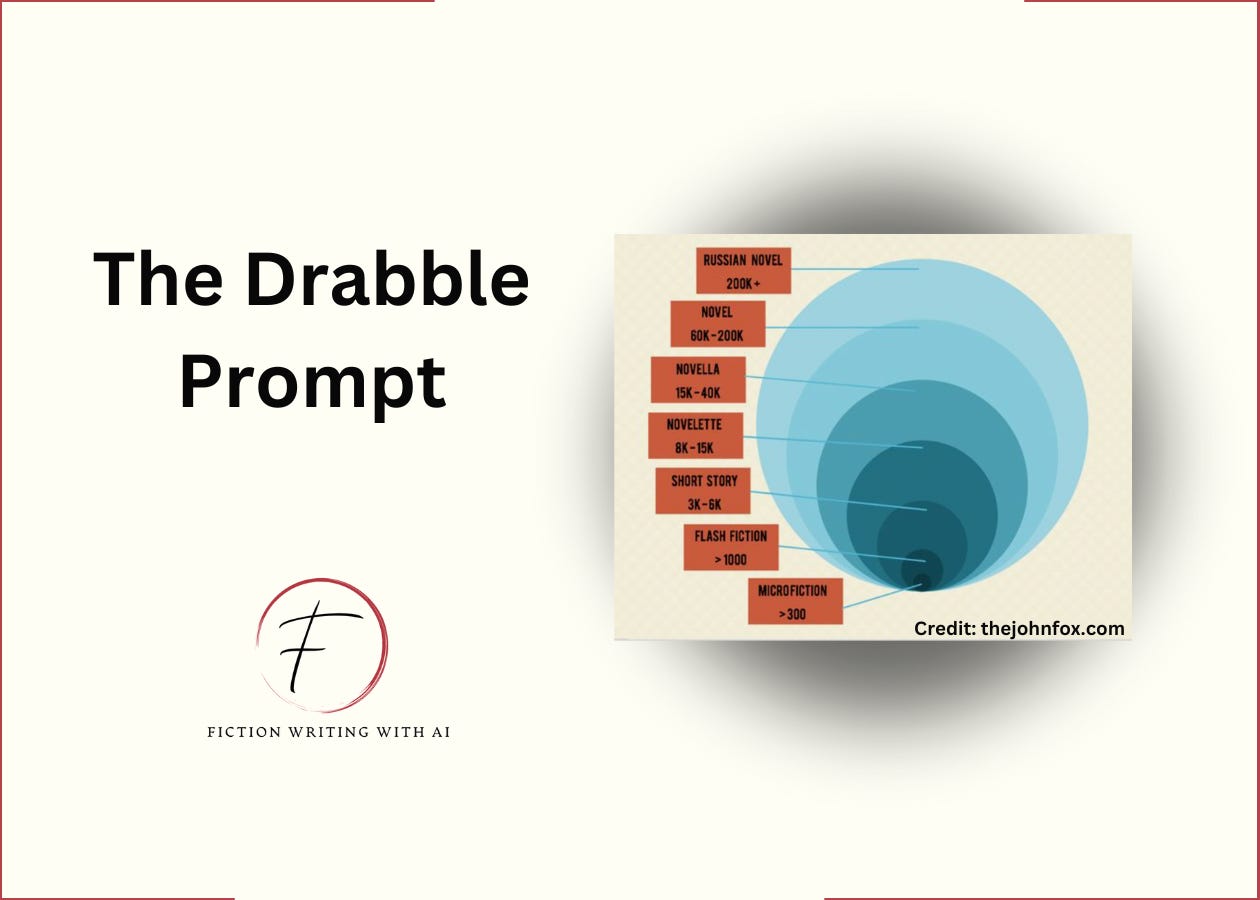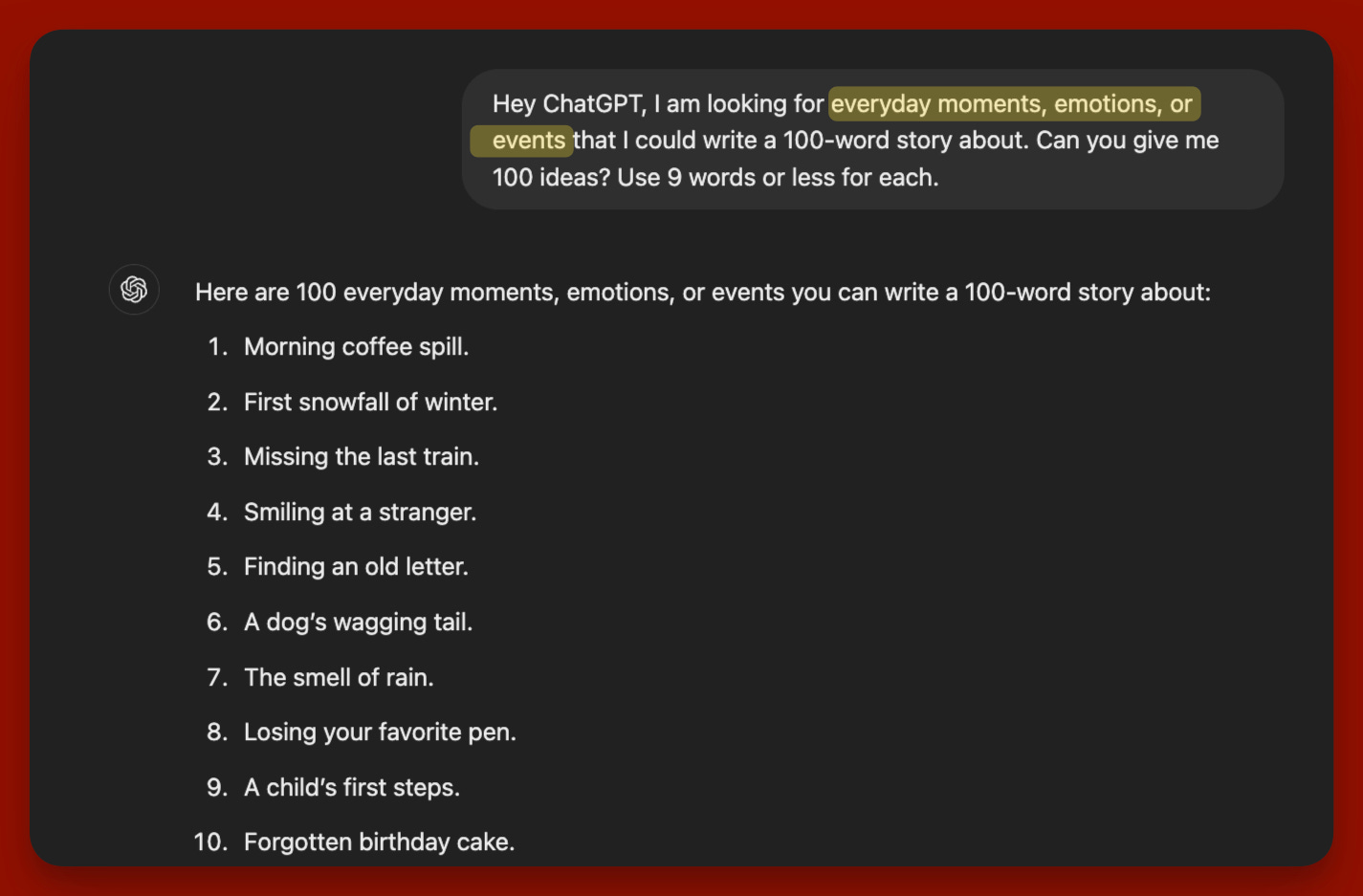Most new fiction writers think you need thousands of words to tell a good story.
You don’t.
100, 55, or even 6 words can say more than an entire Russian Novel. And if you’re just starting out, don't try to write a novel. Start by writing shorter stories. Because writing with fewer words forces you to zero in on what matters—building tension, shaping your character(s), and delivering an emotional payoff without wasting a single word.
Which is why today we are going to write a Drabble.
What In The Heck Is A Drabble?
It's the literary equivalent of an espresso shot.
Quick and potent, story concentrate.
Drabbles are perfect for:
Sharpening your prose
Experimenting with genres
Storing ideas for future projects
Learning to imply rather than explain
The challenge?
You have to use exactly 100 words. No more. No less.
How To Write A Drabble In 4 Steps
Drabbles are limitless—you can write a chilling horror story, a sci-fi romance, or make them as fun or serious as you want.
Let’s break it down.
Step 1: Start With A Moment In Time
Think of a specific experience, emotion, or single event.
For example:
A knight kneels before a dragon, offering his sword in surrender.
A 15-year old girl receives an envelope with life-changing money inside.
You’re deep into your Spotify playlist when an unfamiliar voice says “I’ve been watching you.”
Keep it small and focused.
By narrowing in on a specific moment, you automatically bring clarity to your story.
Need help picking a moment? Try this ChatGPT prompt to get your creative juices flowing.
Step 2: Build Around The Moment
Once you have your moment, focus on these 3 story essentials: Character, Conflict, and Resolution.
Who is the hero—really?
What problem are they facing? What’s at stake?
How is this problem resolved (or left open-ended)? How does it end?
These elements are just as important in micro-fiction as they are in longer stories, and mastering them within a shorter format helps you sharpen your overall storytelling skills.
If you need a little help, pick a moment from Step 1 and ask ChatGPT to answer each question for you.
For example:
It’s time to write.
Step 3: Get To The Point
Since you only have 100 words, every word you write counts.
So, stick to simple, clear sentences. Aim to convey emotion or action without being overly descriptive. Focus on the essential details and get to the point.
Example:
Jane walked to the mailbox. It had been days since anyone sent her anything. Today, a single letter waited for her. Her heart pounded as she tore it open. The words inside left her breathless: "I know who you are." Shee looked around. No one was watching, but her hands trembled. Should she run? Call the police? She crumpled the paper, stuffing it into her pocket. She would decide tomorrow.
This version is only 70 words. Which takes us to the next step.
Step 4: Edit Up Or Down
Our example story is 30 words short.
To meet the Drabble requirement, we need to expand it and edit up. Since the first draft ended with a cliffhanger—“decide tomorrow”—we can focus on resolving the conflict and giving the character a clear decision, bringing it to exactly 100 words.
For example:
Jane walked to the mailbox. It had been days since anyone sent her anything. Today, a single letter waited for her. Her heart pounded as she tore it open. The words inside left her breathless: "I know who you are." She looked around. No one was watching, but her hands trembled. Should she run? Call the police? Taking a deep breath, she marched to her neighbor's house. Mrs. Fletcher opened the door, surprised. Jane held up the letter. "I think this belongs to you." Mrs. Fletcher’s face softened, "It’s from my son. He left it for you as a prank."
This version not only hits the 100-word mark, but also resolves the tension with a light-hearted twist, bringing the story to a satisfying close. Mastering this skill will improve your ability to tie up longer stories, too.
And whether you need to cut down or build up, here are few tips to help you hit your Drabble target:
Show More, Don’t Tell: If you’ve been overly concise, show more through action. Instead of writing, “He was angry,” show him slamming a door or clenching his fists.
Cut Unnecessary Adjectives/Adverbs: Often, adjectives and adverbs can be removed or replaced with stronger nouns and verbs. Instead of “walked slowly,” consider using “strolled” or “crept.” Be specific, but don't over-describe: "The big, round, shiny apple" can just be "the apple" if the rest doesn't add to the story.
Read Aloud: Reading the Drabble aloud will help you notice clunky phrasing or unnecessary words. It also makes the story’s rhythm and flow clearer.
It’s a barbell.
Trim the excess to reveal the core, or add depth to improve the emotional payoff.
Ready To Try Your Hand At A Drabble?
Here's a prompt to get you started:
The Drabble Prompt
Keep reading with a 7-day free trial
Subscribe to Fiction Writing With AI to keep reading this post and get 7 days of free access to the full post archives.






